Azur’s 1/72 Breguet 27
|
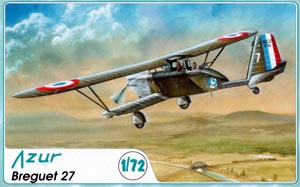 |
History
Quoting from the instructions (which is the only reference I’ve found
so far on this odd little French plane): The Breguet 278 prototype first
flew on February 23rd 1929. This all-metal two-seat observation
sesquiplane was mostly built of steel. It was powered by a 500hp Hispano-Suiza
12Hb. A VIP transport cabin type was also built. A reconnaissance bomber
variant with the 860hp Hispano-Suiza 12Y brs carrying 400kg of bombs,
the Breguet 273 was developed in 1934, and sold to China
and Venezuela,
while a few 27s had been sold to Brazil
and Venezuela.
Many observation units of the Armée de l’Air were flying the type in 1936,
eleven of them still having some at the beginning of WWII. Some missions
were flown before the planes were withdrawn from first line units because
of their vulnerability to German fighters. A few remained in service
after the Armistice.
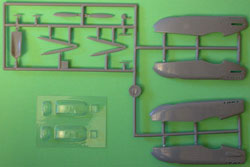 The
Kit The
Kit
This latest from Azur features a combination of injection plastic, vacuformed
acetate and cast resin parts, with a nice decal sheet providing a total
of three options. The plastic parts are very well molded and are of the
long run type now seen in MPM kits. The resin pieces are nicely cast
and add a great deal of detailing to the kit. Both variants are included
in the kit, with the most noticeable difference being in the upper section
of the cowling. Azur answers this difference by providing two complete
fuselages in the kit. The rest of the kit is the same between the two,
so let’s take a look at the insides.
The interior is what the majority of the resin parts are for, so be
prepared for a lot of resin cleanup here. The arrangement in the fuselage
is an interesting one, with a central beam supporting the pilot and observer’s
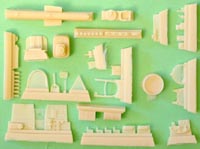 seat.
There’s a control stick on both the front and rear cockpit, as well as
matching rudder pedals. The sidewalls are also resin and have lots of
detail, including the door on the left side. It would have been nice
if Azur had molded this door as open to help show off some of this detailing,
but a careful bit of work with your knife can open this up if you wish.
The instrument panel and throttle quadrant are also separate. The front
seat includes a mounting point for the radio on the back. Once all of
this is put in place you’ll have a very busy-looking office. seat.
There’s a control stick on both the front and rear cockpit, as well as
matching rudder pedals. The sidewalls are also resin and have lots of
detail, including the door on the left side. It would have been nice
if Azur had molded this door as open to help show off some of this detailing,
but a careful bit of work with your knife can open this up if you wish.
The instrument panel and throttle quadrant are also separate. The front
seat includes a mounting point for the radio on the back. Once all of
this is put in place you’ll have a very busy-looking office.
By this time you’ve already decided on which version you’re doing, as
you have to attach the sidewalls to the specific fuselage halves. The
export Breguet features a resin radiator face and both fuselages have
holes for the individual resin exhaust stubs. The propeller is made up
from a resin hub and plastic blades. Once the fuselage is together the
next step is to attach the clear parts, at least the forward windscreen
as this piece provides an attachment point for the upper wing. This is
vacuformed and fairly thin. This, coupled with its vertical arrangement
makes for an interesting joint that will be tough to fill both on the
fuselage and on the upper wing so you’ll want to dry fit this piece over
and over until it is absolutely perfect.
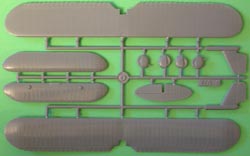 The
flying surfaces are the next step with this kit and being a sesquiplane
we’ll look at the small wing first. This is split into an upper and a
lower half, with mounting points for the landing gear. The landing gear
is fairly basic, with the wheels molded integrally with the pants and
split into right and left halves. These have a peg that fits into a matching
hole in the wing. The completed wing then fits into the cutout in the
finished fuselage. Moving slightly aft, the vertical fin is molded with
the rear tail boom and this assembly is split into a right and left half.
The one-piece stabilizer fits onto the rear of this, while the one-piece
tailwheel gets stuck on the bottom. After that all that’s left is the
upper wing, also split into an upper and a lower half. A total of six
strut pieces support this wing (as well as that center canopy section)
and there are a couple of drawings showing the alignment of the struts.
There is no front view, however, so you’ll have to trust the locating
holes to get things lined up properly that way. The
flying surfaces are the next step with this kit and being a sesquiplane
we’ll look at the small wing first. This is split into an upper and a
lower half, with mounting points for the landing gear. The landing gear
is fairly basic, with the wheels molded integrally with the pants and
split into right and left halves. These have a peg that fits into a matching
hole in the wing. The completed wing then fits into the cutout in the
finished fuselage. Moving slightly aft, the vertical fin is molded with
the rear tail boom and this assembly is split into a right and left half.
The one-piece stabilizer fits onto the rear of this, while the one-piece
tailwheel gets stuck on the bottom. After that all that’s left is the
upper wing, also split into an upper and a lower half. A total of six
strut pieces support this wing (as well as that center canopy section)
and there are a couple of drawings showing the alignment of the struts.
There is no front view, however, so you’ll have to trust the locating
holes to get things lined up properly that way.
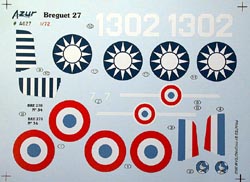 The
decal sheet is well printed by Propagteam and is in excellent register.
There’s two French options and one Chinese. The first French example
is a Breguet 27 of GAO 518, while the second example is a Breguet 27 of
an unknown unit seen at Orly
in June of 1940. Both are finished in khaki overall with the engine nacelle
in silver. The first example features the unit emblem on the rear fuselage
as seen on the boxtop, while the second has a fuselage roundel with a
white bar. The third example is the Chinese Breguet 270 and it too is
painted in khaki overall with a silver engine nacelle. Roundels are on
the wings while the rudder is striped blue and white. A large white ‘1302’
is on the fuselage sides. The
decal sheet is well printed by Propagteam and is in excellent register.
There’s two French options and one Chinese. The first French example
is a Breguet 27 of GAO 518, while the second example is a Breguet 27 of
an unknown unit seen at Orly
in June of 1940. Both are finished in khaki overall with the engine nacelle
in silver. The first example features the unit emblem on the rear fuselage
as seen on the boxtop, while the second has a fuselage roundel with a
white bar. The third example is the Chinese Breguet 270 and it too is
painted in khaki overall with a silver engine nacelle. Roundels are on
the wings while the rudder is striped blue and white. A large white ‘1302’
is on the fuselage sides.
Conclusion
If you’re wanting something really bizarre on your shelf that’ll be
simple to paint, this might be for you. There will be some challenges
in construction, mainly due to the full resin interior and the odd wing
arrangement, but careful assembly will pay off in the end and you’ll have
something that will leave people asking ‘what IS that?”.
|








|

 The
Kit
The
Kit seat.
There’s a control stick on both the front and rear cockpit, as well as
matching rudder pedals. The sidewalls are also resin and have lots of
detail, including the door on the left side. It would have been nice
if Azur had molded this door as open to help show off some of this detailing,
but a careful bit of work with your knife can open this up if you wish.
The instrument panel and throttle quadrant are also separate. The front
seat includes a mounting point for the radio on the back. Once all of
this is put in place you’ll have a very busy-looking office.
seat.
There’s a control stick on both the front and rear cockpit, as well as
matching rudder pedals. The sidewalls are also resin and have lots of
detail, including the door on the left side. It would have been nice
if Azur had molded this door as open to help show off some of this detailing,
but a careful bit of work with your knife can open this up if you wish.
The instrument panel and throttle quadrant are also separate. The front
seat includes a mounting point for the radio on the back. Once all of
this is put in place you’ll have a very busy-looking office. The
flying surfaces are the next step with this kit and being a sesquiplane
we’ll look at the small wing first. This is split into an upper and a
lower half, with mounting points for the landing gear. The landing gear
is fairly basic, with the wheels molded integrally with the pants and
split into right and left halves. These have a peg that fits into a matching
hole in the wing. The completed wing then fits into the cutout in the
finished fuselage. Moving slightly aft, the vertical fin is molded with
the rear tail boom and this assembly is split into a right and left half.
The one-piece stabilizer fits onto the rear of this, while the one-piece
tailwheel gets stuck on the bottom. After that all that’s left is the
upper wing, also split into an upper and a lower half. A total of six
strut pieces support this wing (as well as that center canopy section)
and there are a couple of drawings showing the alignment of the struts.
There is no front view, however, so you’ll have to trust the locating
holes to get things lined up properly that way.
The
flying surfaces are the next step with this kit and being a sesquiplane
we’ll look at the small wing first. This is split into an upper and a
lower half, with mounting points for the landing gear. The landing gear
is fairly basic, with the wheels molded integrally with the pants and
split into right and left halves. These have a peg that fits into a matching
hole in the wing. The completed wing then fits into the cutout in the
finished fuselage. Moving slightly aft, the vertical fin is molded with
the rear tail boom and this assembly is split into a right and left half.
The one-piece stabilizer fits onto the rear of this, while the one-piece
tailwheel gets stuck on the bottom. After that all that’s left is the
upper wing, also split into an upper and a lower half. A total of six
strut pieces support this wing (as well as that center canopy section)
and there are a couple of drawings showing the alignment of the struts.
There is no front view, however, so you’ll have to trust the locating
holes to get things lined up properly that way. The
decal sheet is well printed by Propagteam and is in excellent register.
There’s two French options and one Chinese. The first French example
is a Breguet 27 of GAO 518, while the second example is a Breguet 27 of
an unknown unit seen at
The
decal sheet is well printed by Propagteam and is in excellent register.
There’s two French options and one Chinese. The first French example
is a Breguet 27 of GAO 518, while the second example is a Breguet 27 of
an unknown unit seen at 





